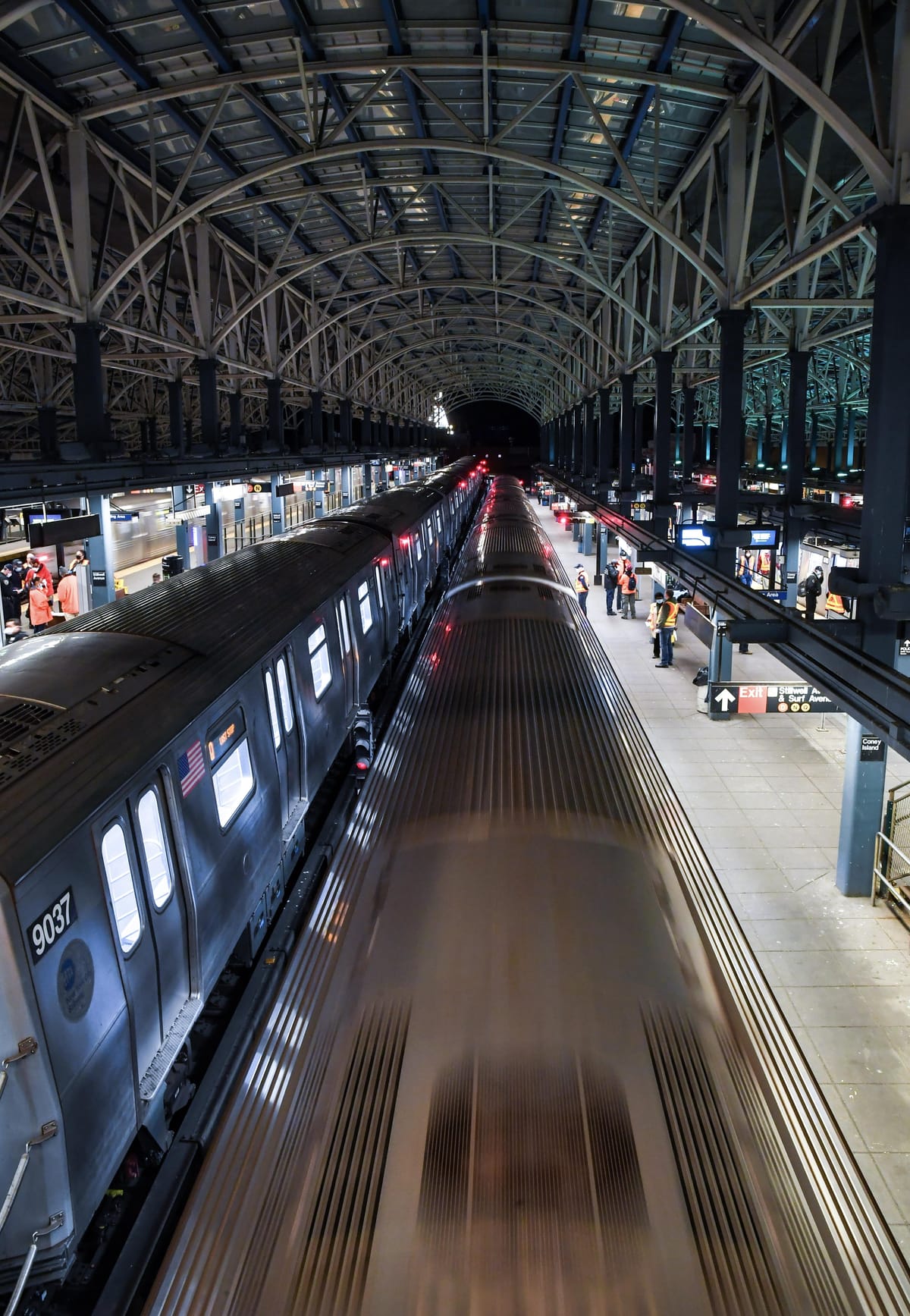Restored C and F Train Service, Congestion Pricing Progress and Other Transportation Updates


Even as the coronavirus pandemic has profoundly disrupted New York’s public transit services and sent the Metropolitan Transportation Authority finances into a chaotic spiral, several other important transportation stories continue to play out across the city.
Here’s the latest on what’s happening with our trains, buses and streets.
The federal government gives congestion pricing the go-ahead
After more than a year of delays imposed by the administration of former president Donald Trump, New York’s ambitious plan to charge drivers to enter Manhattan below 60th Street can finally move forward.
The state legislature passed its congestion pricing plan in 2019, with an anticipated start date of January 2021. But the program needed federal approval, and the Trump administration effectively blocked the project by refusing to tell the state whether the policy would require a long and expensive “Environmental Impact Statement,” or simply a lighter “Environmental Assessment.”
Yesterday, the Federal Highway Administration, now run by President Joe Biden’s DOT Commissioner Pete Buttigieg, announced the project could move forward with the simpler assessment.
“This approach will ensure that the public participates as local and state leaders explore new possibilities for reducing congestion, improving air quality and investing in transit to increase ridership,” Acting Federal Highway Administrator Stephanie Pollack said in a statement announcing the news.
Experts say the congestion pricing scheme could generate $1 billion in tolls annually, which would be used to issue $15 billion in bonds that the MTA can use to make much-needed capital improvements to the aging subway system.
Governor Andrew Cuomo celebrated the announcement, as did Mayor Bill de Blasio, who called it “a big step forward.” Both elected officials were previously skeptical of the plan.
Still, many questions remain unanswered, including how long the assessment will take, how much tolls will cost, and who will need to pay them. All sorts of stakeholders and interest groups have sought exemptions under the plan; if too many are approved, they risk undercutting the policy’s effectiveness.
The MTA’s finances remain precarious, despite receiving $14 billion in federal relief last year and this year combined. Transit advocates worry the governor will siphon off dedicated MTA funds during this week’s state budget negotiations.
Cuts to C and F train service will be restored
As the pandemic overran the city in March 2020, the MTA reduced service on all subway lines, converting to what it called an essential service plan by the end of the month.
The MTA restored much of that service in August—but not the 36 F train trips and 5 C train trips it had cut. Ridership on those two lines stayed down nearly 85% from pre-pandemic levels, according to agency data, resulting in longer wait times between trains. During peak commuting hours, wait times for F trains have increased by 4 minutes, and by 12 minutes on the C.
But less than a month after Transport Workers Union Local 100 filed a lawsuit over the cuts, arguing they violated state law, the MTA announced yesterday that full service would be restored.
“We’re going to make sure all our C and F riders are getting as much service as we can,” Sarah Feinberg, NYC Transit’s interim president, announced during a panel organized by the Citizens Budget Commission.
She said F train service would return by early May, but said C train service would take several additional weeks to resume.
The MTA had previously defended the cuts as “rightsizing” service to accommodate lower subway ridership, which overall remains down 65% from before the pandemic.
The advocacy group Riders Alliance celebrated the announcement.
“By restoring frequent service on the C and F subway lines, the MTA is delivering for today’s riders and helping bring New Yorkers back to transit,” organizing manager Stephanie Burgos-Veras said in a statement. “Riders will continue to demand frequent, reliable and accessible service, including 24/7 subways.”
Cuomo ended 24-hour subway service last May; currently, the subway system remains closed from 2:00am to 4:00am nightly, during which time MTA crews remove homeless people and disinfect train cars.
But Feinberg also signalled that 24-hour service could resume in the near future.
“As the city comes back we’ve got to become a 24-hour system again,” she said during the panel. “I think we’re rapidly approaching a point where we’re beginning to get there.”
The MTA wants more cops in the subways
Feinberg made another striking statement at the Citizens Budget Commission forum: she wants NYPD presence “in every station and, frankly, on every platform.”
“We’re at a critical moment where people have to come back into the system and they have to feel like they’re safe,” she said.
The New York Daily News quickly ran the math and determined that deploying multiple officers on each of the city’s 1,000 subway platforms throughout the day would require at least 6,000 officers.
That’s more manpower, the tabloid noted, than the number of U.S. troops currently in Afghanistan and Iraq, and more than the 5,500 soldiers in New York’s National Guard.
The NYPD deployed 644 new officers into the subway system in February after a random slashing rampage left two people dead and two others wounded. The NYPD’s Transit Bureau oversees about 2,500 officers in total.
In December 2019, the MTA board approved the hiring of 500 of its own police officers to help patrol the subways, separate from the NYPD, which took over policing the system in the mid-90s. But the agency’s pandemic-driven financial crisis slowed the effort; as of February, the agency had hired just 218 officers.
But advocates for the homeless have criticized the reliance on policing.
“Mayor de Blasio and Governor Cuomo need to respond not with more stigmatization and callousness toward people without homes, or heavy-handed police removals, but with real and immediate access to housing for unsheltered New Yorkers,” Giselle Routhier, policy director for the Coalition for the Homeless, told ABC News last month.
The City Council approves legislation to create a “DOT Crash Investigation Unit”
A bill passed last week by the City Council makes the Department of Transportation, not the NYPD, the lead agency in investigating vehicle crashes, a change long sought by advocates who say the NYPD’s Collision Investigation Squad is biased in favor of drivers.
The bill, which was sponsored by Council Transportation Committee Chair Ydanis Rodriguez, creates a DOT crash investigation and analysis unit to investigate, analyze and report on vehicle crashes involving significant injury. It will also make public reports of its crash reviews, and recommend changes to street design and infrastructure that can improve safety.
“This legislation will significantly improve how we approach crash investigations, how crashes are communicated to the media, how we better bring justice to survivors, and we applaud the council for passing this legislation today,” Marco Conner DiAquoi, Deputy Director of Transportation Alternatives, said in a statement celebrating the law’s passage.
The bill passed 39-10, after the Council added language clarifying that the NYPD would retain responsibility for criminal investigations of reckless drivers. Mayor de Blasio has indicated that he will sign it into law.
Open Streets is coming back—but boosters are frustrated by de Blasio’s approach
De Blasio is getting heat for his announcement last week of a new application process for open streets, Streetsblog reports, including from some of the elected officials and volunteers whose names were on the press release.
Many were frustrated by the vagueness of the announcement, and upset the program will still rely so heavily on volunteer effort instead of city support.
“Implementation of this program has to be accessible and equitable to neighborhoods across the city, such as those without BIDs or non profits to jump into the fray,” Gib Veconi, chair of the Prospect Heights Neighborhood Development Council, told Streetsblog.
“It can’t be a barrier, if you don’t have resources. That’s the strongest argument for this being internalized by the city. It is something that has to happen.”




